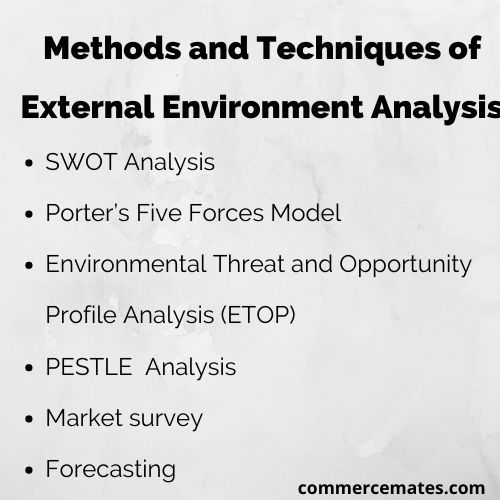Contents
Meaning External Environment Analysis
External Environment analysis refers to the study of the external environment within which business operates. It means analyzing the external forces which affect the functioning of business either directly or indirectly. Proper study of the external environment is important in shaping a better future for business and attaining desired growth. It helps in finding out the opportunities or threats available for a business that may lead to profitability and growth.
External environment analysis helps management in framing proper business strategies as per the requirements thereby keeping business ahead of the competition. The external environment of business is categorized into two categories: Microenvironment and the macro environment.
Micro external environment includes all those factors that directly affect the operations of business like suppliers, competitors, customers, market intermediaries, public, etc. Whereas, the macro external environment consists of such factors that are general in nature and affects the whole industry but not a particular company. The macro external environment includes the political, social, economic, technological and demographic environments. Tools and Techniques of External environment analysis can be well-understood form points given below:
Methods and Techniques of External Environment Analysis

SWOT Analysis
SWOT analysis means analyzing the strength, weaknesses, opportunities, and threats of the business environment. Strengths and weaknesses are internal factors whereas opportunities and threats are external factors affecting the performance of the business. SWOT analysis is an efficient technique in understanding both internal and external environments of a business which thereby helps in framing better strategies.
Porter’s Five Forces Model
This technique analyses the five forces that affect business. Porter’s five forces model focuses on potential entrants, buyers, suppliers, existing competitors and alternatives products or services available in the market. The proper study of these forces helps in creating better policies that will help in keeping business ahead.
Environmental Threat and Opportunity Profile Analysis (ETOP)
ETOP method analyses the environmental threats and opportunities. It identifies the opportunities available to businesses and threats that may restrain it. ETOP technique divides the environment into different sections and performs a systematic environmental scanning to study their impact on business.
PESTLE Analysis
PESTLE analysis is an external environment analysis tool that focuses on analyzing the political, economic, social, technological, legal and environmental forces influencing the business. PESTLE provides a full overview of the external environment by analyzing these 6 forces and helps in strategic planning for the business.
Market survey
Market survey is another effective tool used for analyzing the external environment of business. It involves acquiring information by interacting with the peoples in the market which helps in knowing the new trends and challenges. This way companies are able to meet the requirements and likings of customers.
Forecasting
Forecasting means predicting the future information on the basis of collected information. Here future events are estimated using different techniques like survey method, observation method, time series analysis, brainstorming, etc.